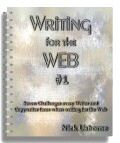 One of the things every copywriter learns is to do plenty of research.
One of the things every copywriter learns is to do plenty of research.
Whatever the product or service you are selling, you need to dig deep and learn everything about it…before you start writing your sales copy.
If you don’t know…and I mean REALLY know…what you are trying to sell, your sales copy will feel thin and lacking in any persuasive oomph.
I experienced this myself recently while reading a draft written by a youngish copywriter. The copy felt thin. I didn’t get a deep, reassuring feeling for the product being sold. So I emailed the copywriter and asked him about the research he had done before putting pen to paper.
It turned out that he had simply worked from the information provided by the client and had done no additional research of his own. And that was a bit silly, because the client had provided contact information for the person who created the product. The client had assumed the writer would get in touch with this person and grill him for more information. Didn’t happen.
So that’s lesson one…always do as much research as you can. The more deeply you understand the product or service, the better your chances are of writing some great copy.
But now we come to step two, which is a subset of that other rule…know who your readers are. As well as understanding the product or service, you also have to understand the person you are writing to. Fail to do that and you’ll bomb.
The subset of knowing your customer is this: Assume they know absolutely nothing about what you are trying to sell.
In other words, know your product, know your customers…but don’t make any assumptions about what the customer may or may not already know about the product.
To give you a sense of what I mean by this, think about the last time you purchased a new digital camera. You turned to the instruction manual and got totally lost within about 30 seconds. (At least, that’s what happened to me recently.)
How come? Because the authors of the manual made assumptions about what I might already know. They took shortcuts and skimmed over stuff because they assumed I already had a certain body of knowledge.
The same happens with instructions on websites. We want to complete a task, but get lost along the way. (At this point, the webmaster suggests that any site visitor who gets lost is too stupid to buy the product anyway. Wrong. In fact, the webmaster is too arrogant to create an experience that is actually helpful to his or her visitors.)
And…the same thing happens when writing copy.
As we are writing, with our minds full to the brim with all we have learned about the product we are selling, it’s all too easy to make assumptions about our readers’ level of knowledge.
We know so much about the product ourselves, it feels normal to assume our readers know something about it. (In the same way the webmaster knows everything about his website and how it works, and then assumes a first-time visitor will share at least some of that knowledge.)
In the same way, your readers can get lost just as quickly when reading your page of sales copy.
Here’s a way to avoid making this mistake.
1. Make a list of all the points and product features YOU want to write about, because you and your client feel they will help drive sales.
2. Make a list of all the points and product features you have chosen not to mention, because you DON’T feel they will help drive the sale.
3. Look at that second list and ask yourself, “Even if these points and features don’t directly contribute to the persuasive flow of my copy, by excluding them am I running the risk of confusing and losing my reader?”
The key here is to understand that before you can make a sale you have to help your readers fully comprehend what you are talking about and offering.
If they don’t “get it”, “see it” and understand it, you’ll lose them.
Next time you start writing a page of copy, assume your readers know nothing.
NOTE: If you have yet to receive any professional-grade training in the craft of online copywriting, find out more about my program, Copywriting 2.0. Copywriting 2.0 is published by AWAI, and you can find their information and sales page for the program here…
About the author: Nick Usborne is an online writer, copywriter, author and coach. Read more…
If you found this post helpful, sign up for my e-newsletter and get a free copy of my 35-page guide…
Writing For The Web #1 — 7 Challenges every Writer and Copywriter faces when writing for the Web.
Sign up and I’ll send you the link for the download, and then you’ll receive my most recent post as part of my e-newsletter every Tuesday morning.
(Your email address will be used only for the purpose of sending you this newsletter, and you’ll be free to unsubscribe at any time.)


The paradox of copy writing. You want to be an expert on what you write and not talk like an expert 🙂
This is one of the basic truths, but …
If you are doing business to business, presuming that your audience knows nothing of your product/solution/whatever does not make it less important to know and to communicate at the level and in the jargon of your prospects. This is really an important part of your research: Finding (and learning) enough about the general knowledge background of your target group and the language they use when talking about it. Otherwise you risk making your client come across as a complete moron, with no pertinent background whatsoever …
Wille